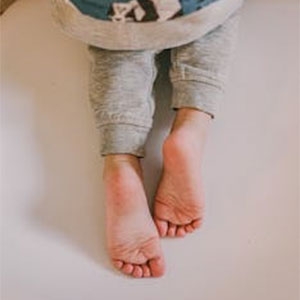Flat feet, also known as fallen arches, is a condition in which the arches of the feet are significantly reduced or absent, causing the entire sole of the foot to touch the ground when standing. While many children have flat feet, it can cause discomfort and pain in some cases. Here's an explanation of how flat feet can cause pain and how it can be treated:
How Flat Feet Cause Pain:
- Lack of Support: The arches of the feet act as natural shock absorbers, distributing the body's weight evenly across the foot. In flat feet, this support is compromised, leading to increased stress on the feet, ankles, knees, and even the lower back.
- Overpronation: Children with flat feet may tend to overpronate, which means the feet roll too far inward while walking or running. This abnormal gait can put strain on the muscles and ligaments in the feet and legs, leading to pain and discomfort.
- Tendon Strain: Flat feet can put extra strain on the tendons in the feet, causing inflammation and pain. This can be particularly noticeable after physical activities or long periods of standing.
- Foot Fatigue: Due to the lack of proper arch support, children with flat feet may experience foot fatigue more quickly than those with normal arches.
Treatment of Flat Feet:
- Supportive Shoes: Properly fitting and supportive shoes can make a significant difference. Look for shoes with good arch support, cushioning, and stability. Avoid shoes with high heels or inadequate support, as they can exacerbate the pain.
- Orthotic Inserts: Orthotic shoe inserts or arch supports can help provide additional support to the feet and correct any biomechanical issues, reducing pain and discomfort.
- Physical Therapy: Consult a physical therapist who can recommend exercises and stretches to strengthen the muscles and improve foot function. Physical therapy can also address any alignment issues that contribute to the pain.
- Rest and Ice: If the child experiences pain or inflammation, rest and applying ice to the affected area can help alleviate symptoms.
- Avoidance of High-Impact Activities: Limiting activities that put excessive strain on the feet, such as running or jumping on hard surfaces, can help reduce pain.
- Weight Management: Maintaining a healthy weight can lessen the load on the feet and lower extremities, reducing pain and discomfort.
It's essential for parents to monitor their child's symptoms and seek professional medical advice if the pain persists or significantly impacts the child's daily activities. A healthcare provider, such as a pediatrician or a podiatrist, can assess the severity of the flat feet and recommend appropriate treatment options tailored to the child's specific needs. In some cases, if conservative treatments are not sufficient, medical intervention, such as custom-made orthotics or surgery, might be considered.

